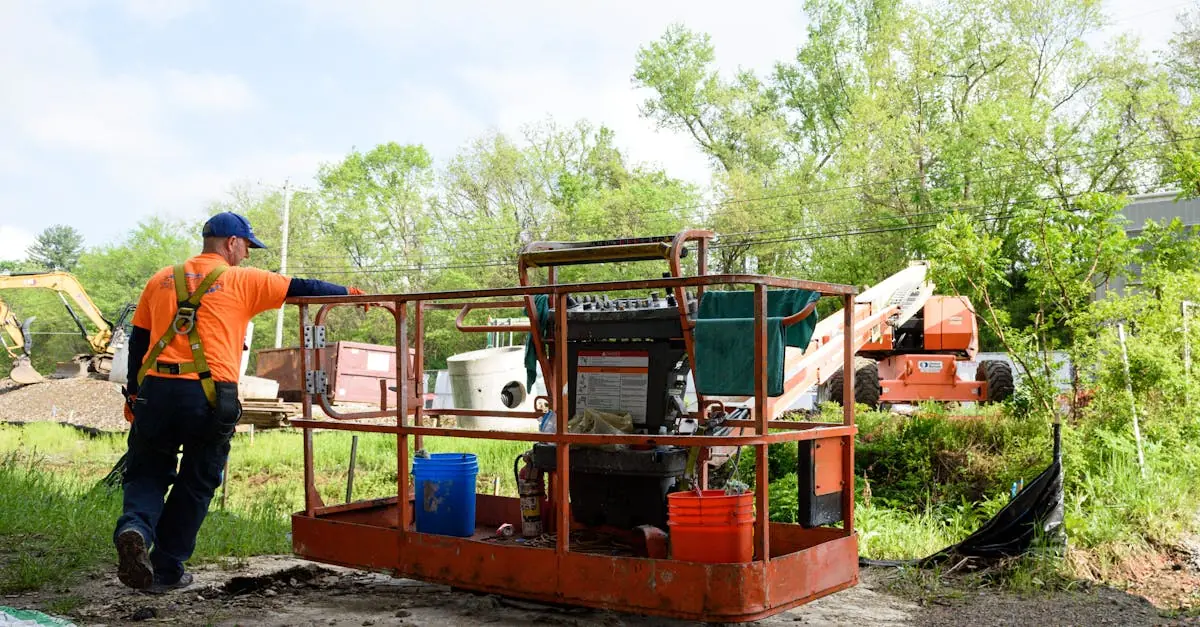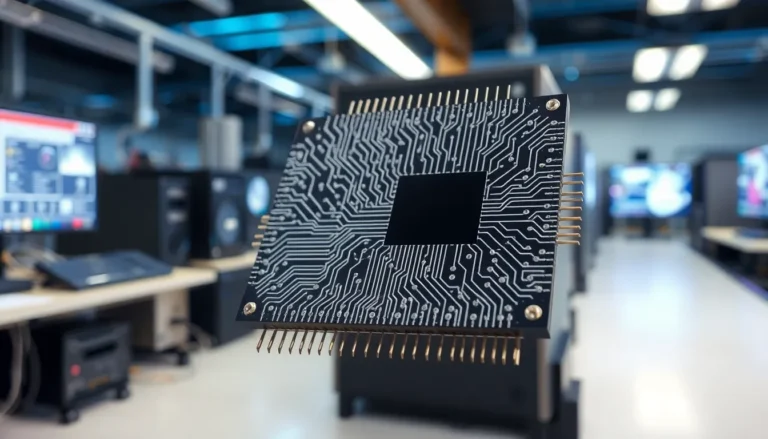The construction industry is no stranger to innovation, but the Internet of Things (IoT) is shaking things up like a jackhammer on a Monday morning. Imagine a world where hard hats are smarter than your average smartphone, and construction sites run smoother than a well-oiled machine. With IoT, that world isn’t just a pipe dream—it’s becoming a reality.
Table of Contents
ToggleOverview of IoT in Construction
The Internet of Things (IoT) introduces significant advancements in the construction industry. Smart devices and sensors improve monitoring, ensuring real-time data availability. These technologies enhance safety, reduce costs, and optimize operations on construction sites.
A key benefit involves asset tracking. Equipment tracking systems can pinpoint location and usage stats, streamlining management. Such systems reduce equipment theft and maintenance costs, leading to financial savings.
Another critical aspect encompasses project management. IoT tools facilitate collaboration among stakeholders, providing transparency in daily operations. Real-time updates allow for quick decision-making, resulting in fewer delays and unexpected costs.
Environmental sustainability also gains support through IoT applications. Sensors monitor energy consumption and emissions, allowing for data-driven adjustments. These metrics help in adhering to regulations and minimizing environmental impact.
Data analytics plays a vital role by processing information from IoT devices. Analytics identify patterns, improving forecasting and resource allocation. Construction companies leverage this data to enhance efficiency and project timelines.
Examples of IoT tools include drones and wearable technology. Drones survey large areas quickly, capturing detailed aerial imagery. Wearables, like smart helmets, monitor worker health and safety, ensuring compliance with safety protocols.
Integration of IoT into construction represents a shift towards smarter job sites. Automation of routine tasks frees skilled workers to focus on complex problem-solving. This trend not only enhances productivity but also fosters innovation across the industry.
Understanding IoT’s role in construction drives growth in this sector. Adoption of these technologies prepares companies for future challenges, paving the way for more efficient and effective project execution.
Benefits of IoT in Construction
The integration of IoT technology offers numerous advantages in the construction industry, enhancing safety, efficiency, and data collection.
Enhanced Safety Measures
Smart sensors and wearable devices significantly improve worker safety on construction sites. Safety wearables monitor vital signs, alerting supervisors to potential health issues. Additionally, IoT-enabled cameras provide real-time surveillance, identifying unsafe practices or hazardous conditions. Automated alerts can notify workers of potential dangers, allowing for quicker responses. Furthermore, equipment tracking helps ensure that machinery is in good condition, reducing the risk of accidents caused by faulty equipment.
Improved Efficiency
IoT applications streamline construction processes by optimizing resource allocation. Automated machinery executes tasks more precisely, minimizing waste and reducing project timelines. Sensor data helps teams manage equipment usage, preventing redundancy and ensuring that resources are used effectively. Workflow coordination between different teams improves collaboration, shortening the time it takes to complete projects. As a result, IoT enhances overall productivity and accelerates project delivery, providing a competitive edge.
Real-time Data Collection
Real-time data collection transforms how construction companies make decisions. IoT devices gather and transmit vital information, allowing managers to assess project progress instantly. This constant flow of data supports immediate adjustments to plans, minimizing delays and cost overruns. Analyzing trends from collected data helps identify inefficiencies and areas for improvement. Emphasizing data-driven strategies fosters a culture of continuous improvement, essential for modern construction methodologies.
Challenges in Implementing IoT in Construction
Implementing IoT in construction faces several challenges that can hinder its effectiveness and adoption. Key areas include cost concerns and security issues.
Cost Considerations
Cost factors play a significant role in IoT implementation. High initial investment in devices and infrastructure presents barriers for many construction companies. Many firms may struggle to allocate budgets for IoT technologies. Maintenance expenses also add to the overall financial burden. Training personnel to effectively use these new technologies incurs additional costs. Despite these challenges, the potential for long-term savings through improved efficiency and reduced labor costs makes it a worthwhile investment for many. Firms that can manage these costs might find themselves at an advantage in the competitive construction market.
Security Concerns
Security poses a critical challenge in IoT deployment. Vulnerability to cyberattacks threatens not only equipment but also sensitive project data. Many IoT devices lack robust security features, increasing the risk of breaches. Inadequate network security can lead to unauthorized access, potentially causing major disruptions. Companies must prioritize implementing strong cybersecurity measures and training staff on security protocols. Taking these steps is essential to safeguard data integrity and maintain trust among stakeholders. As firms navigate these challenges, addressing security concerns can enhance confidence in IoT solutions.
Case Studies of IoT in Construction
IoT technology has demonstrated significant success in the construction industry. Numerous case studies illustrate its effectiveness.
Successful Implementations
A large-scale construction firm implemented IoT sensors for real-time monitoring of equipment usage and site conditions. These sensors led to a 30% reduction in equipment theft and lowered maintenance costs. Another construction company utilized drones equipped with cameras for site surveying. By adopting this technology, they decreased surveying time by 50%, streamlining project timelines. Additionally, wearable devices have been deployed on construction sites to monitor worker health statistics, reducing injury rates by 20% through proactive alerts. These examples underscore how IoT has reshaped operational efficiencies and workplace safety in construction.
Lessons Learned
Initial investments in IoT devices can be substantial, presenting challenges for many companies. Companies that have embraced IoT reported the importance of comprehensive training programs for staff to enhance system effectiveness. Stakeholder engagement emerged as a critical factor, ensuring smooth integration of IoT technology into existing workflows. Furthermore, cybersecurity must be prioritized, as vulnerabilities can compromise sensitive data. Successful implementations highlighted the need for ongoing support and maintenance, which play vital roles in sustaining IoT solutions. Each of these lessons contributes to building confidence in IoT technologies within the construction sector.
Future Trends of IoT in Construction
Emerging trends in IoT will play a pivotal role in shaping the construction industry. Increased integration of artificial intelligence can enhance data analytics capabilities, leading to smarter decision-making processes. Deployment of advanced drones for site inspections is likely to continue, further reducing time and labor costs associated with manual surveying.
Smart wearables will see broader adoption, allowing for real-time health monitoring of workers to ensure safety standards are met. Evolving regulations around building sustainability are expected to drive demand for IoT solutions that monitor energy use and optimize resource consumption. Companies will increasingly leverage these technologies to comply with environmental standards while improving operational efficiency.
Robotics and automation will rise in prominence as IoT devices connect seamlessly, enabling machinery to perform repetitive or dangerous tasks autonomously. Enhanced collaboration tools will emerge, utilizing real-time data to facilitate communication among project stakeholders, thereby reducing delays and improving transparency.
The focus on cybersecurity will intensify as more devices connect to the Internet. Construction firms will prioritize investments in robust security protocols to protect sensitive data and maintain client trust. Addressing these concerns will be essential to unlock the full potential of IoT in construction.
Another trend includes the widespread implementation of predictive maintenance technologies. By analyzing usage patterns and wear-and-tear data, companies can schedule maintenance proactively, reducing downtime and extending equipment lifespan.
Capitalizing on these trends positions construction companies for growth. Innovations driven by IoT will create smarter job sites and improve overall productivity, fundamentally transforming construction practices.
The integration of IoT in construction is paving the way for a more efficient and innovative industry. By leveraging smart devices and real-time data, construction companies can enhance safety, streamline operations, and reduce costs. The ongoing evolution of IoT technologies promises to further transform job sites, making them smarter and more productive.
As firms navigate the challenges of implementation, including costs and cybersecurity, the long-term benefits of IoT adoption become increasingly clear. Companies that embrace these advancements will not only improve project outcomes but also position themselves as leaders in a rapidly changing landscape. The future of construction is bright with IoT at the forefront, driving growth and sustainability in the sector.




